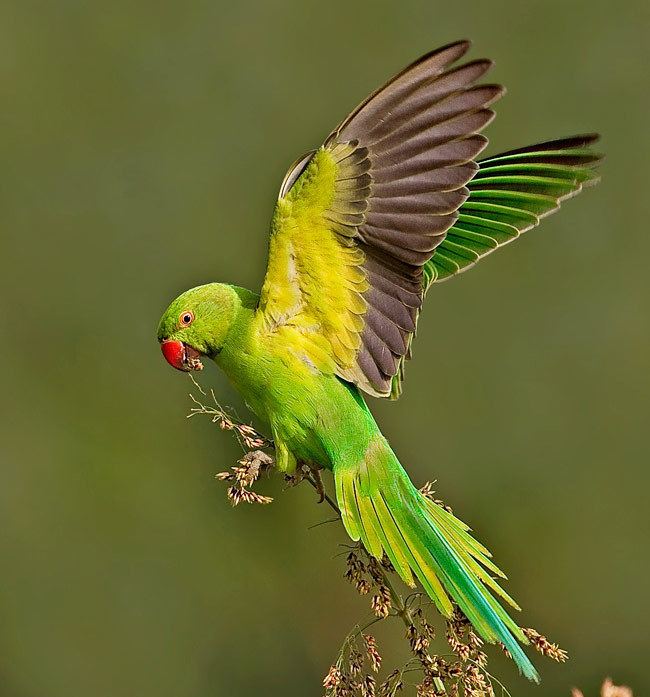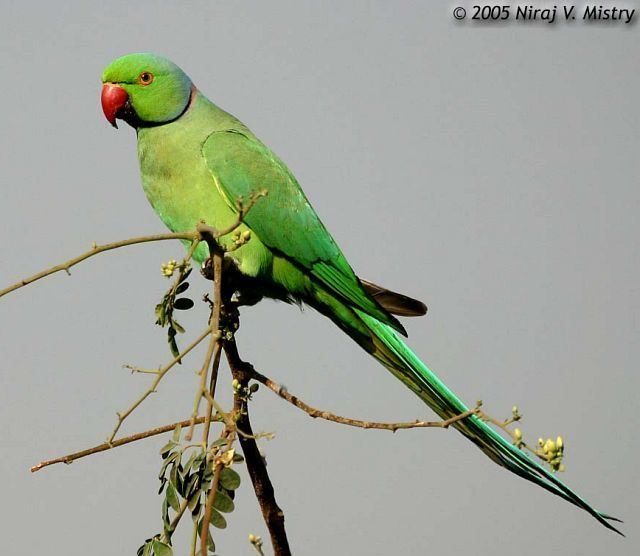Superfamily Psittacoidea Subfamily Psittaculinae Rank Species | Order Psittaciformes Tribe Psittaculini Mass 130 g (Adult) Phylum Chordata | |
 | ||
Conservation status Least Concern (Population increasing) Similar Parrot, Bird, Psittacula, Alexandrine parakeet, Cockatiel | ||
The rose-ringed parakeet (Psittacula krameri), also known as the ring-necked parakeet, is a gregarious tropical Afro-Asian parakeet species that has an extremely large range.
Contents

The rose-ringed parakeet is sexually dimorphic. The adult male sports a red or black neck ring and the hen and immature birds of both sexes either show no neck rings, or display shadow-like pale to dark grey neck rings. Both sexes have a distinctive green colour. Rose-ringed parakeets measure on average 40 cm (16 in) in length, including the tail feathers, a large portion of their total length. Their average single-wing length is about 15–17.5 cm (5.9–6.9 in). In the wild, this is a noisy species with an unmistakable squawking call. It is herbivorous and not migratory.

One of the few parrot species that have successfully adapted to living in disturbed habitats, it has withstood the onslaught of urbanisation and deforestation. As a popular pet species, escaped birds have colonised a number of cities around the world. Since the population appears to be increasing, the species was evaluated as being of least concern by the IUCN in 2012, but its popularity as a pet and unpopularity with farmers have both reduced its numbers in some parts of its native range.

The genus name Psittacula is a diminutive of Latin psittacus, "parrot", and the specific krameri commemorates the Austrian naturalist Wilhelm Heinrich Kramer.

Distribution
Four subspecies are recognized, though they differ little:
Phylogeny
A phylogenetic analysis using DNA (see Psittacula) showed that the Mauritius parakeet (Psittacula echo) is closely related to this species, and probably needs to be placed between the African and Asian subspecies. Consequently, this species is paraphyletic.
Diet
In the wild, rose-ringed parakeets usually feed on buds, fruits, vegetables, nuts, berries, and seeds. Wild flocks also fly several miles to forage in farmlands and orchards, causing extensive damage.
In India, they feed on cereal grains, and during winter also on pigeon peas. In Egypt during the spring, they feed on mulberry and in summer they feed on dates and nest inside palm trees and eat from sunflower and corn fields.
In captivity, rose-ringed parakeets will take a large variety of food and can be fed on a number of fruits, vegetables, pellets, seeds, and even small amounts of cooked meat for protein. Oils, salts, chocolate, alcohol, and other preservatives should be avoided.
Reproduction
In north-west India, Indian rose-ringed parakeets form pairs from September to December. They do not have life mates and often breed with another partner during the following breeding season. During this cold season, they select and defend nest sites, thus avoiding competition for sites with other birds. Feeding on winter pea crops provides the female with nutrients necessary for egg production. From April to June, they care for their young. Fledgings are ready to leave the nest before monsoon.
Aviculture
Rose-ringed parakeets are popular as pets and they have a long history in aviculture. The ancient Greeks kept the Indian subspecies P. krameri manillensis, and the ancient Romans kept the African subspecies P. krameri krameri. Colour mutations of the Indian rose-ringed parakeet subspecies have become widely available in recent years.
Mimicry
Both males and females have the ability to mimic human speech. First, the bird listens to its surroundings, and then it copies the voice of the human speaker. Some people hand-raise rose-ringed parakeet chicks for this purpose. Such parrots then become quite tame and receptive to learning.
Feral birds
A popular pet, the rose-ringed parakeet has been released in a wide range of cities around the world, giving it an environment with few predators where their preferred diet of seeds, nuts, fruits, and berries is available from suburban gardens and bird feeders. Its adaptations to cold winters in the Himalayan foothills allow it to easily withstand European winter conditions. It has established feral populations in a number of European cities, South Africa and Japan. There are also apparently stable populations in the US (Florida, California and Hawaii) and small self-sustaining populations in Ankara (concentrated in parks), Tunis, Tripoli and Tehran (concentrated in the north side of the city). It is also found throughout Lebanon, Israel, the UAE, Bahrain, Qatar, and Oman. A small number of escaped birds are in Australia.
The European populations became established during the mid-to-late 20th century. The main British populations are based around London, primarily in the western and south-western suburbs. They can be regularly seen in places such as Crystal Palace Park, Battersea Park, Richmond Park, Wimbledon Common, Greenwich Park, and Hampstead Heath, as well as Surrey and Berkshire. A large population in the south-west of London, consisting of many thousands of birds, is known as the Kingston parakeets. The winter of 2006 had three separate roosts of about 6000 birds around London. A smaller population occurs around Margate, Broadstairs and Ramsgate, Kent. There is also an established population to the North East of London in Essex at Loughton and Theydon Bois by Epping Forest. Elsewhere in Britain, smaller feral populations have become established from time to time (e.g., at Sefton Park and Greenbank Park in Liverpool, Studland, Dorset, Kensington Gardens, and south Manchester). It has been suggested that feral parrots could endanger populations of native British birds, and that the rose-ringed parakeet could even be culled as a result. A major agricultural pest in locations such as India, as of 2011 the rose-ringed parakeet population was growing rapidly, but is generally limited to urban areas in southern England
In the Netherlands, the feral population in the four largest urban areas (Amsterdam, Rotterdam, Utrecht and especially in The Hague) was estimated at 10,000 birds in 2010, almost double the number of birds estimated in 2004. There also exists a feral population in Belgium, with as many as 5,000 pairs estimated in Brussels. These originate from an original population that was set free in 1974 by the owner of the Meli Zoo and Attraction Park near the Atomium who wanted to make Brussels more colourful. In Germany, these birds are found along the Rhine in all major urban areas such as Cologne, Düsseldorf (about 800 birds), Bonn, Ludwigshafen and Heidelberg, Wiesbaden and in the north-east of Hamburg. Other populations are found around Paris, Rome — notably in the gardens of the Palatine Hill, the trees of the Trastevere and Janiculum and at Villa Borghese, in the Orto Botanico di Palermo in Palermo, in Genoa, in Barcelona and in Lisbon.
The specimens in these naturalized populations often represent intra-specific hybrids, originally between varying numbers (according to locality) of the subspecies manillensis, borealis, and/or (to a lesser extent) krameri along with some inter-specific hybrids with naturalized Psittacula eupatria (Alexandrine parakeet).
However, in some parts of South Asia (from where the rose-ringed parakeets originated), populations of these birds are decreasing due to trapping for the pet trade. Despite some people's attempts to revive their population by freeing these birds from local markets, the rose-ringed parakeet's population has dropped drastically in many areas of the Indian subcontinent.
Where introduced, rose-ringed parakeets may affect native biodiversity and human economy and wellness.
There is a feral population of the birds in Japan. In the 1960s many Japanese people became pet owners for the first time and the parakeet was widely imported as a pet. Some escaped or were released and formed populations around the country. By the 1980s groups could be found in Tokyo, Osaka, Nagoya, Niigata and Kyushu. Some groups since died out, but as of 2009 there is a large population residing at the Tokyo Institute of Technology's main campus at Ookayama, along with small groups in Maebashi and Chiba city.
